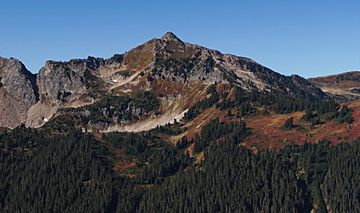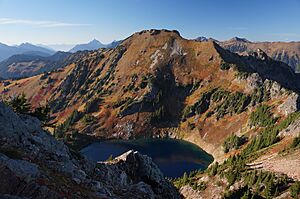Johnson Mountain (Washington) facts for kids
Quick facts for kids Johnson Mountain |
|
|---|---|

Johnson Mountain seen from Pilot Ridge
|
|
| Highest point | |
| Elevation | 6,721 ft (2,049 m) |
| Prominence | 1,241 ft (378 m) |
| Geography | |
| Location | Glacier Peak Wilderness Snohomish County, Washington |
| Parent range | Cascade Range |
| Topo map | USGS Benchmark Mountain |
| Climbing | |
| Easiest route | Hiking trail |
Johnson Mountain is a tall peak in Washington state. It stands about 6,721 feet (2,049 meters) high. This mountain is part of the beautiful Glacier Peak Wilderness. It's located in the North Cascades mountain range.
You can find Johnson Mountain in eastern Snohomish County. It is within the Mt. Baker-Snoqualmie National Forest. The water that flows off the mountain goes into streams that join the Sauk River. The mountain is named after Mackinaw Johnson. He was a prospector who lived nearby.
Contents
How Mountains Formed
The North Cascades mountains are known for their rugged look. They have sharp peaks, tall spires, and deep valleys carved by glaciers. These amazing shapes were created by geological events. These events happened millions of years ago. They caused big changes in height across the Cascade Range. This also led to different climates in the area.
Earth's Moving Plates
The Cascade Mountains started forming a very long time ago. This was during the late Eocene Epoch. The North American Plate is a huge piece of Earth's crust. It moved over the Pacific Plate. This movement caused volcanoes to erupt many times.
Glacier Peak is a large volcano. It is about 8.52 miles (13.71 kilometers) north of Johnson Mountain. This volcano began to form during the mid-Pleistocene period. Also, small pieces of Earth's crust, called terranes, helped create the North Cascades. This happened about 50 million years ago.
Ice and Erosion
During the Pleistocene period, which was over two million years ago, glaciers were very active. They moved forward and backward many times. As they moved, they scraped the land. This left behind lots of rock debris. The river valleys in this area have a "U" shape. This shape was made by recent glaciers.
The lifting of land (called uplift) and cracks in the Earth (called faulting) worked with the glaciers. These processes have been the main forces. They created the tall peaks and deep valleys you see in the North Cascades today.
Mountain Weather
Johnson Mountain is in a marine west coast climate zone. This type of climate is found in western North America. Most weather systems start over the Pacific Ocean. They then travel northeast towards the Cascade Range.
Rain and Snow
As these weather systems reach the North Cascades, the mountains force them upward. This process is called Orographic lift. When the air rises, it cools down. This causes the moisture in the air to fall as rain or snow on the mountains. Because of this, the western side of the North Cascades gets a lot of rain and snow. This is especially true during the winter.
Temperatures and Sunshine
The climate here is mild because it's close to the Pacific Ocean. Areas west of the Cascade Crest rarely get very cold or very hot. Temperatures are almost never below 0°F (-18°C) or above 80°F (27°C). In winter, it's usually cloudy. But in summer, high-pressure systems over the Pacific Ocean get stronger. This often means there are few or no clouds, making for sunny days.




